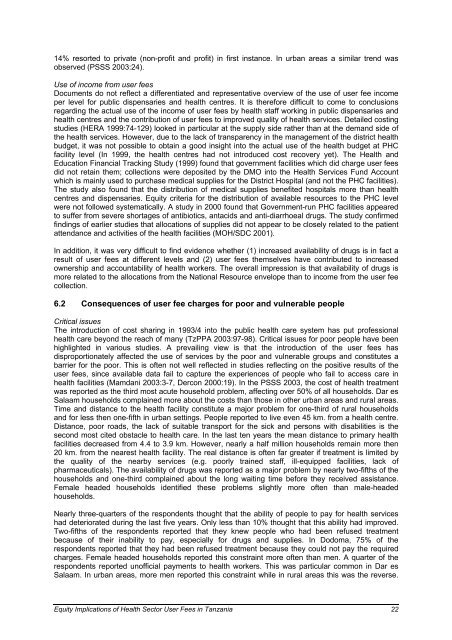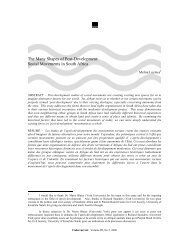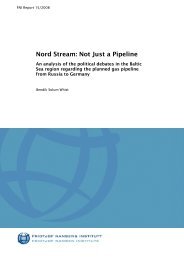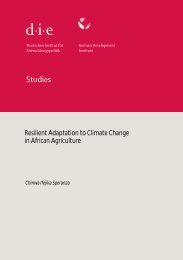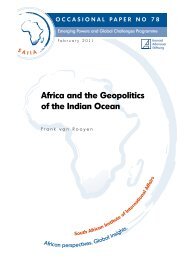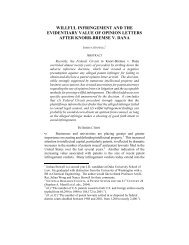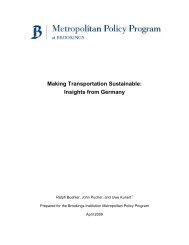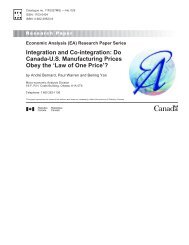equity implications of health sector user fees in tanzania
equity implications of health sector user fees in tanzania
equity implications of health sector user fees in tanzania
You also want an ePaper? Increase the reach of your titles
YUMPU automatically turns print PDFs into web optimized ePapers that Google loves.
14% resorted to private (non-pr<strong>of</strong>it and pr<strong>of</strong>it) <strong>in</strong> first <strong>in</strong>stance. In urban areas a similar trend was<br />
observed (PSSS 2003:24).<br />
Use <strong>of</strong> <strong>in</strong>come from <strong>user</strong> <strong>fees</strong><br />
Documents do not reflect a differentiated and representative overview <strong>of</strong> the use <strong>of</strong> <strong>user</strong> fee <strong>in</strong>come<br />
per level for public dispensaries and <strong>health</strong> centres. It is therefore difficult to come to conclusions<br />
regard<strong>in</strong>g the actual use <strong>of</strong> the <strong>in</strong>come <strong>of</strong> <strong>user</strong> <strong>fees</strong> by <strong>health</strong> staff work<strong>in</strong>g <strong>in</strong> public dispensaries and<br />
<strong>health</strong> centres and the contribution <strong>of</strong> <strong>user</strong> <strong>fees</strong> to improved quality <strong>of</strong> <strong>health</strong> services. Detailed cost<strong>in</strong>g<br />
studies (HERA 1999:74-129) looked <strong>in</strong> particular at the supply side rather than at the demand side <strong>of</strong><br />
the <strong>health</strong> services. However, due to the lack <strong>of</strong> transparency <strong>in</strong> the management <strong>of</strong> the district <strong>health</strong><br />
budget, it was not possible to obta<strong>in</strong> a good <strong>in</strong>sight <strong>in</strong>to the actual use <strong>of</strong> the <strong>health</strong> budget at PHC<br />
facility level (In 1999, the <strong>health</strong> centres had not <strong>in</strong>troduced cost recovery yet). The Health and<br />
Education F<strong>in</strong>ancial Track<strong>in</strong>g Study (1999) found that government facilities which did charge <strong>user</strong> <strong>fees</strong><br />
did not reta<strong>in</strong> them; collections were deposited by the DMO <strong>in</strong>to the Health Services Fund Account<br />
which is ma<strong>in</strong>ly used to purchase medical supplies for the District Hospital (and not the PHC facilities).<br />
The study also found that the distribution <strong>of</strong> medical supplies benefited hospitals more than <strong>health</strong><br />
centres and dispensaries. Equity criteria for the distribution <strong>of</strong> available resources to the PHC level<br />
were not followed systematically. A study <strong>in</strong> 2000 found that Government-run PHC facilities appeared<br />
to suffer from severe shortages <strong>of</strong> antibiotics, antacids and anti-diarrhoeal drugs. The study confirmed<br />
f<strong>in</strong>d<strong>in</strong>gs <strong>of</strong> earlier studies that allocations <strong>of</strong> supplies did not appear to be closely related to the patient<br />
attendance and activities <strong>of</strong> the <strong>health</strong> facilities (MOH/SDC 2001).<br />
In addition, it was very difficult to f<strong>in</strong>d evidence whether (1) <strong>in</strong>creased availability <strong>of</strong> drugs is <strong>in</strong> fact a<br />
result <strong>of</strong> <strong>user</strong> <strong>fees</strong> at different levels and (2) <strong>user</strong> <strong>fees</strong> themselves have contributed to <strong>in</strong>creased<br />
ownership and accountability <strong>of</strong> <strong>health</strong> workers. The overall impression is that availability <strong>of</strong> drugs is<br />
more related to the allocations from the National Resource envelope than to <strong>in</strong>come from the <strong>user</strong> fee<br />
collection.<br />
6.2 Consequences <strong>of</strong> <strong>user</strong> fee charges for poor and vulnerable people<br />
Critical issues<br />
The <strong>in</strong>troduction <strong>of</strong> cost shar<strong>in</strong>g <strong>in</strong> 1993/4 <strong>in</strong>to the public <strong>health</strong> care system has put pr<strong>of</strong>essional<br />
<strong>health</strong> care beyond the reach <strong>of</strong> many (TzPPA 2003:97-98). Critical issues for poor people have been<br />
highlighted <strong>in</strong> various studies. A prevail<strong>in</strong>g view is that the <strong>in</strong>troduction <strong>of</strong> the <strong>user</strong> <strong>fees</strong> has<br />
disproportionately affected the use <strong>of</strong> services by the poor and vulnerable groups and constitutes a<br />
barrier for the poor. This is <strong>of</strong>ten not well reflected <strong>in</strong> studies reflect<strong>in</strong>g on the positive results <strong>of</strong> the<br />
<strong>user</strong> <strong>fees</strong>, s<strong>in</strong>ce available data fail to capture the experiences <strong>of</strong> people who fail to access care <strong>in</strong><br />
<strong>health</strong> facilities (Mamdani 2003:3-7, Dercon 2000:19). In the PSSS 2003, the cost <strong>of</strong> <strong>health</strong> treatment<br />
was reported as the third most acute household problem, affect<strong>in</strong>g over 50% <strong>of</strong> all households. Dar es<br />
Salaam households compla<strong>in</strong>ed more about the costs than those <strong>in</strong> other urban areas and rural areas.<br />
Time and distance to the <strong>health</strong> facility constitute a major problem for one-third <strong>of</strong> rural households<br />
and for less then one-fifth <strong>in</strong> urban sett<strong>in</strong>gs. People reported to live even 45 km. from a <strong>health</strong> centre.<br />
Distance, poor roads, the lack <strong>of</strong> suitable transport for the sick and persons with disabilities is the<br />
second most cited obstacle to <strong>health</strong> care. In the last ten years the mean distance to primary <strong>health</strong><br />
facilities decreased from 4.4 to 3.9 km. However, nearly a half million households rema<strong>in</strong> more then<br />
20 km. from the nearest <strong>health</strong> facility. The real distance is <strong>of</strong>ten far greater if treatment is limited by<br />
the quality <strong>of</strong> the nearby services (e.g. poorly tra<strong>in</strong>ed staff, ill-equipped facilities, lack <strong>of</strong><br />
pharmaceuticals). The availability <strong>of</strong> drugs was reported as a major problem by nearly two-fifths <strong>of</strong> the<br />
households and one-third compla<strong>in</strong>ed about the long wait<strong>in</strong>g time before they received assistance.<br />
Female headed households identified these problems slightly more <strong>of</strong>ten than male-headed<br />
households.<br />
Nearly three-quarters <strong>of</strong> the respondents thought that the ability <strong>of</strong> people to pay for <strong>health</strong> services<br />
had deteriorated dur<strong>in</strong>g the last five years. Only less than 10% thought that this ability had improved.<br />
Two-fifths <strong>of</strong> the respondents reported that they knew people who had been refused treatment<br />
because <strong>of</strong> their <strong>in</strong>ability to pay, especially for drugs and supplies. In Dodoma, 75% <strong>of</strong> the<br />
respondents reported that they had been refused treatment because they could not pay the required<br />
charges. Female headed households reported this constra<strong>in</strong>t more <strong>of</strong>ten than men. A quarter <strong>of</strong> the<br />
respondents reported un<strong>of</strong>ficial payments to <strong>health</strong> workers. This was particular common <strong>in</strong> Dar es<br />
Salaam. In urban areas, more men reported this constra<strong>in</strong>t while <strong>in</strong> rural areas this was the reverse.<br />
Equity Implications <strong>of</strong> Health Sector User Fees <strong>in</strong> Tanzania 22


